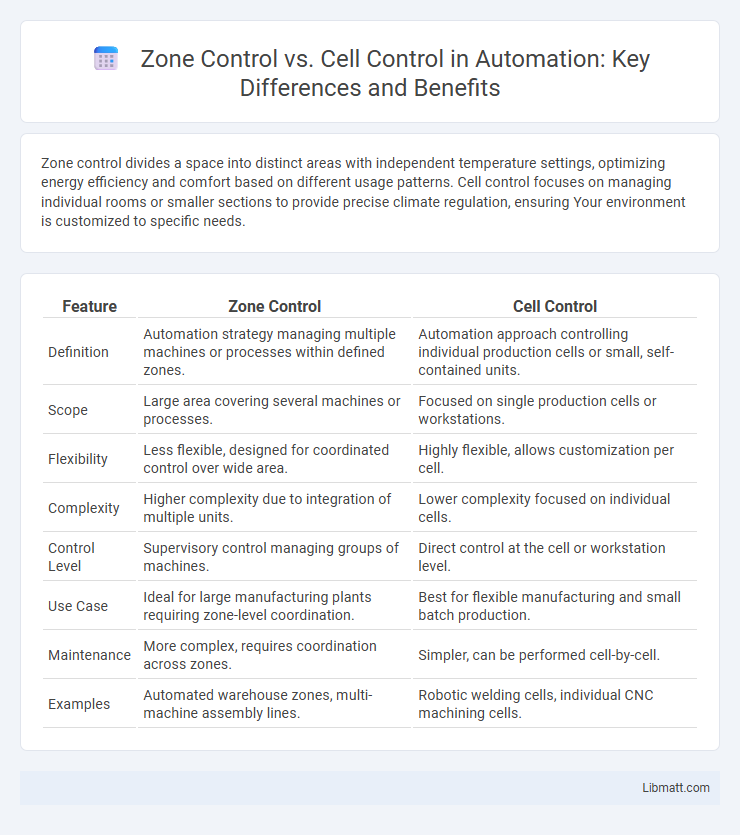Zone control divides a space into distinct areas with independent temperature settings, optimizing energy efficiency and comfort based on different usage patterns. Cell control focuses on managing individual rooms or smaller sections to provide precise climate regulation, ensuring Your environment is customized to specific needs.
Table of Comparison
| Feature | Zone Control | Cell Control |
|---|---|---|
| Definition | Automation strategy managing multiple machines or processes within defined zones. | Automation approach controlling individual production cells or small, self-contained units. |
| Scope | Large area covering several machines or processes. | Focused on single production cells or workstations. |
| Flexibility | Less flexible, designed for coordinated control over wide area. | Highly flexible, allows customization per cell. |
| Complexity | Higher complexity due to integration of multiple units. | Lower complexity focused on individual cells. |
| Control Level | Supervisory control managing groups of machines. | Direct control at the cell or workstation level. |
| Use Case | Ideal for large manufacturing plants requiring zone-level coordination. | Best for flexible manufacturing and small batch production. |
| Maintenance | More complex, requires coordination across zones. | Simpler, can be performed cell-by-cell. |
| Examples | Automated warehouse zones, multi-machine assembly lines. | Robotic welding cells, individual CNC machining cells. |
Introduction to Zone Control and Cell Control
Zone Control and Cell Control represent two strategic approaches in wireless network management, optimizing resource allocation and interference mitigation. Zone Control divides the coverage area into larger sections, managing radio resources to reduce interference between zones, while Cell Control focuses on smaller individual cells, enhancing capacity and signal quality at a granular level. Effective implementation of both methods can significantly improve network efficiency, user experience, and overall system performance in cellular communications.
Definitions: Zone Control vs Cell Control
Zone Control refers to a wireless network architecture that divides a coverage area into overlapping zones managed by individual controllers to optimize roaming and load balancing. Cell Control, on the other hand, manages wireless access at the level of individual cells or access points, providing more granular control over local connectivity and interference. Understanding these distinctions can help you select the appropriate control strategy for enhancing network performance and user experience.
Historical Evolution of Control Strategies
Zone control systems emerged as an advancement over early building automation methods by dividing buildings into distinct zones, allowing more precise temperature regulation and energy efficiency compared to traditional single-thermostat setups. Cell control evolved later with the rise of wireless sensor networks and IoT technology, enabling granular, real-time monitoring and adaptive control at the individual cell level within zones. Understanding the historical evolution of these strategies helps optimize your building's climate management by leveraging the improved flexibility and responsiveness inherent in modern cell control systems.
Key Differences Between Zone and Cell Control
Zone control divides a facility into larger heating or cooling zones regulated by thermostats, ideal for managing similar environmental needs across broader spaces. Cell control offers precise temperature management in individual work cells or small areas, enhancing comfort and energy efficiency by tailoring climate conditions to specific tasks or equipment. The key difference lies in scale and precision, with zone control optimizing broader areas and cell control providing targeted thermal regulation.
Advantages of Zone Control
Zone Control offers enhanced flexibility in managing HVAC systems by dividing spaces into various thermal zones, allowing precise temperature adjustments that improve energy efficiency and comfort. It reduces operational costs by optimizing heating and cooling based on occupancy patterns and specific zone requirements. Your building benefits from improved air quality and consistent climate control tailored to each zone, leading to increased occupant satisfaction and system longevity.
Benefits of Cell Control
Cell Control enhances network efficiency by enabling localized management and faster response times, reducing latency compared to Zone Control. It provides improved scalability and flexibility through independent control of each cell, facilitating optimized resource allocation and interference management. Enhanced user experience is achieved with Cell Control due to better handover performance and targeted quality of service adjustments.
Challenges and Limitations of Each Approach
Zone control in wireless networks faces challenges like limited scalability and interference management due to overlapping coverage areas, which can cause signal degradation and reduced network efficiency. Cell control encounters limitations related to handoff complexity and resource allocation, as managing individual cells requires sophisticated algorithms to maintain seamless connectivity and load balancing. Both approaches must address trade-offs between coverage precision and operational overhead to optimize network performance.
Industry Applications: Zone Control vs Cell Control
Zone Control systems are widely used in large industrial facilities such as warehouses and manufacturing plants where controlling specific HVAC zones improves energy efficiency and occupant comfort. Cell Control is preferred in environments like data centers and cleanrooms where precise, localized control over individual cells or small areas ensures optimal conditions and minimizes risk. Your choice between Zone Control and Cell Control depends heavily on the granularity of control required and the specific application demands within your industry.
Choosing the Right Control Strategy
Choosing the right control strategy between zone control and cell control depends on the specific operational requirements and production layout of your facility. Zone control optimizes efficiency by managing multiple machines within defined zones, enhancing coordination and throughput, while cell control provides focused oversight for individual work cells, improving flexibility and quality control. Assessing factors such as system complexity, product variability, and desired scalability will help you determine the best approach to maximize productivity and minimize downtime.
Future Trends in Control System Optimization
Future trends in control system optimization emphasize the integration of AI-driven analytics and machine learning algorithms to enhance both Zone Control and Cell Control strategies. Advances in sensor technology and IoT connectivity enable real-time data collection, allowing systems to adapt dynamically for improved energy efficiency and operational precision. Your facility can leverage these innovations to achieve superior responsiveness and scalability in managing complex environments.
Zone Control vs Cell Control Infographic

 libmatt.com
libmatt.com